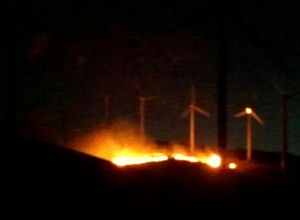
Wind company fails to call fire department, lets blaze burn overnight
By Miriam Raftery
Photo: Tehachapi fire, 2012
April 27, 2013 (San Diego’s East County)—Why is there no federal requirement for wind farm operators to report fires?
That troubling fact came to light following a turbine malfunction that caused a fire, destroying a $4 million wind turbine at the Kibby Mountain facility in Maine. Opponents accuse Trans-Canada of a cover up, the Bangor Daily News reports. (Trans-Canada, builder of the project, is also the company seeking to construct the controversial Keystone Pipeline.)
A sensor in the turbine detected the fire. But an employee did not arrive on scene until the next morning, after the fire had burned itself out. The fire department was never notified, nor was any state agency. Had the blaze not occurred in winter with snow on the ground, the fire could have spread to the adjacent forest, a Maine forestry official has stated.
ECM has asked Cal-Fire in an e-mail whether wind facility operators are required to report fires to fire officials. No response has been received.
The turbines were made by Vestas. The company’s turbines have previously been involved in fires elsewhere, including an April 2013 fire in Ontario, Canada, a March 30, 2012 fire in Germany a June 2012 fire in Spain, and a 2011 fire in Scotland in which a turbine ignited in high winds.
The wind industry claims wind turbine fires are rare. But the facts suggest otherwise. Vestas is not the only manufacturer plagued with fires linked to equipment failures. Hundreds of fires have occurred, and likely more, since there is no reporting requirement in many locations.
Two brush fires in California in July 2012 were caused by wind turbines. A wind turbine fire in Riverside caused a wildfire that burned 367 acres; nearby residents in a box canyon narrowly escaped disaster. Also last summer, a wind turbine sparked a grass fire in Tehachapi.
The website “Turbines on Fire” observes that “ you only have to look at insurers reports to get a better understanding of accident rates and insurance claims made by wind energy developers to get a truer account of the health and safety aspect of turbines. According to the IMIA Insurance of Wind Turbines report, a report that was compiled based on 15 years of the Wind Energy industry in Danish markets; Mechanical faults (blade failure and other faults) accounted for 40% of claims, Lightning accounted for 20% of claims, Fire accounted for 7% of claims, Storm accounted for 4% of claims, Liability for 0.5% of claims, and Others (LOP, short circuit, etc.) accounted for 28.5% of claims.
In December 2011 the Daily Telegraph reported that RenewableUK confirmed that there had been 1500 wind turbine accidents and incidents in the UK alone in the past 5 years.
Caithness Wind Farms compiled a detailed report on wind farm accidents throughout the UK and Internationally, by sourcing news articles, accident reports and insurance documents. They state that “fire is the second most common accident cause in incidents found. ..The biggest problem with wind turbine fires is that, because of the turbine height, the fire brigade can do little but watch it burn itself out…. in a storm it means burning debris being scattered over a wide area,… In dry weather there is obviously a wider-area fire risk.” Moreover, the site reveals, “Two fire accidents have badly burned wind industry workers.”
Fires can occur from numerous sources besides turbine malfunctions, including lightning strikes and wildland fires that start outside the wind facility.
Wind turbines are proposed in the most-fire prone areas of the nation, including multiple massive wind projects in East County. Each turbine also contains hundreds of gallons for flammable fuel oil, a situation some fire officials have warned is a recipe for disaster if a fire starts at a wind project during dry conditions with Santa Ana winds.
Common sense dictates that locating wind projects in high-fire risk areas close to homes in rugged terrain is extremely risky. Failing to require wind facility operators to promptly notify the local fire department is foolhardy, since wind companies would have every incentive to try and hide fires that could paint a negative picture of the industry’s safety record.












Recent comments